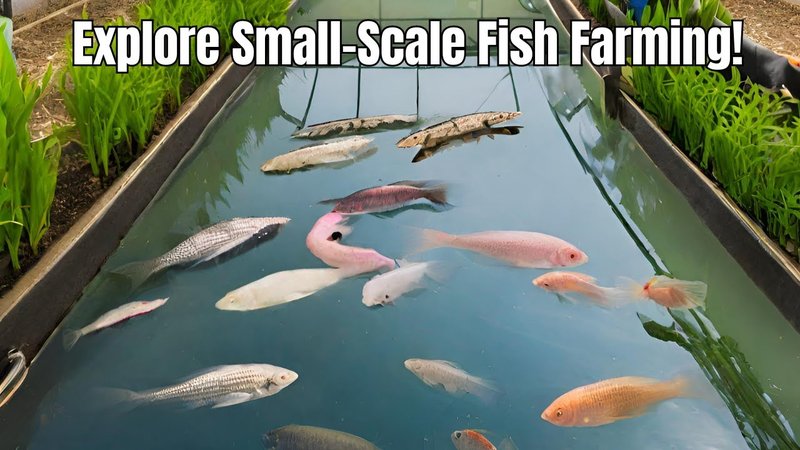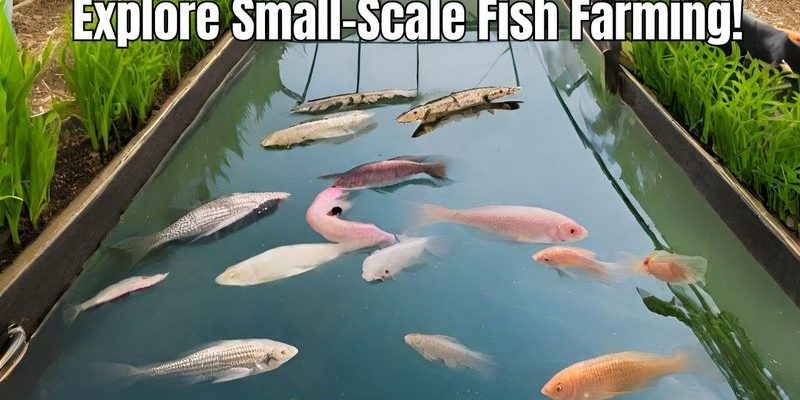
Here’s the thing: starting a fish farm at home doesn’t mean you need a million-dollar setup. You can start small, even if you have a limited space. Maybe you’ve got a little corner in your backyard, a spacious garage, or even just a couple of large tanks indoors. With the right knowledge and a bit of commitment, anyone can kick off their own fish farming adventure. So, grab a cup of coffee, and let’s dive into how to get started!
Choosing the Right Fish for Your Farm
When it comes to starting a small-scale fish farm, the first big decision is which species of fish you want to raise. Your choice should be influenced by your climate, available space, and personal preferences. Some popular options for beginners include tilapia, catfish, and goldfish.
Tilapia, for example, are hardy fish that adapt well to various water conditions. They’re also fast-growing and can be a good source of protein. On the other hand, catfish are another great choice, particularly if you’re in warmer climates. They tend to be very forgiving in terms of water quality and are known for their tasty fillets.
If you’re looking for something a bit more decorative and less for eating, consider keeping goldfish or koi. They require a little less attention in terms of food and water conditions, making them perfect for beginners or for those who may want to create a beautiful pond.
Understanding Your Local Regulations
Before you dive into fish farming, it’s important to check local regulations regarding fish farming. Some areas have specific rules about the species you can raise or the size of your setup. Reach out to local agricultural or wildlife authorities to make sure you’re compliant.
Also, think about permits you may need. In some regions, you might need a license to operate a fish farm, even on a small scale. Don’t skip this step; it’s crucial for avoiding any fines down the line.
Setting Up Your Fish Farm
Now that you’ve chosen the right fish and checked local regulations, it’s time to set up your fish farm. Depending on your space and budget, you can create a variety of setups.
If you have outdoor space, consider building a small pond or using large stock tanks. Stock tanks are a great option because they’re easy to set up and maintain. You can find them at farm supply stores, and they come in various sizes to suit your needs.
If you’re limited on space, an aquarium or a few smaller tanks can work just as well. The key here is to maintain a balance in your setup. Make sure you have enough water volume for your fish to thrive, along with adequate filtration and aeration systems.
Water Quality Requirements
One of the most critical aspects of fish farming is maintaining water quality. Fish need clean, well-oxygenated water to survive and grow. Regularly test the pH levels, ammonia, nitrite, and nitrate levels in your water.
Here are some essential tips for water quality management:
- Use a reliable water test kit to monitor levels.
- Change 10-20% of the water weekly to keep it fresh.
- Consider using a good quality aquarium filter to keep the water clean.
Keeping an eye on these factors will help ensure your fish stay healthy and productive.
Feeding Your Fish
Feeding your fish might seem straightforward, but it’s a vital part of fish farming. Different species have different dietary needs. Most commercially available fish food is designed to meet these requirements, but you should always read the labels carefully.
For example, tilapia do well on a diet high in plant-based proteins, while catfish thrive on protein-rich pellets. You might even want to supplement their diet with some fresh vegetables occasionally.
Here’s a quick feeding guide:
- Feed your fish 2-3 times a day, but only what they can consume in a few minutes.
- Avoid overfeeding. Uneaten food can pollute the water.
- Watch for signs of hunger, like fish swimming near the surface eagerly.
Seeing your fish grow healthy and strong can be incredibly satisfying!
Common Fish Farming Challenges
Like any hobby or business, fish farming has its challenges. One common issue is disease. Fish can be susceptible to various illnesses, especially if the water quality isn’t ideal. Make sure to keep an eye out for unusual behaviors or physical signs of illness.
Another challenge is predators. If you have outdoor setups, birds or raccoons may see your fish as a tasty snack. Consider fencing or netting to protect your fish from potential threats.
Lastly, managing the environment can be tricky, especially during extreme weather conditions. Make sure your tanks or ponds have some shade to keep the water temperature regulated.
Harvesting Your Fish
After all the hard work you’ve put into raising your fish, you might eventually want to harvest them. The timing will depend on the species. For instance, tilapia usually reach market size in about six months, while catfish can take a bit longer.
When it’s time to harvest, make sure you’re prepared. Have a clean workspace ready for processing your catch. If you’re unsure how to properly handle or clean your fish, consider looking up tutorials or asking someone with experience for help.
Not only will you enjoy the fruits of your labor, but you’ll also have a great story to share about your home fish farming journey.
Sharing Your Success
Once you’ve raised your fish, consider sharing your experience with friends and family. You can host a small fish fry or even give some of your harvest away. Who knows? You might inspire someone else to start their own fish farm!
Every step of this journey can be rewarding, from planning to harvesting. You’ll gain not just fish but also a sense of accomplishment and a deeper understanding of nature.
Starting a small-scale fish farm at home can be an exciting journey filled with challenges and rewards. With the right knowledge, planning, and dedication, you can create a thriving environment for fish right in your backyard or even indoors.
Remember to choose the right fish, maintain water quality, and keep an eye on your fish’s health. Before you know it, you’ll be enjoying the fruits of your labor. Whether you’re looking for a new hobby or a sustainable food source, fish farming offers plenty of opportunities for growth and learning. Happy fish farming!

